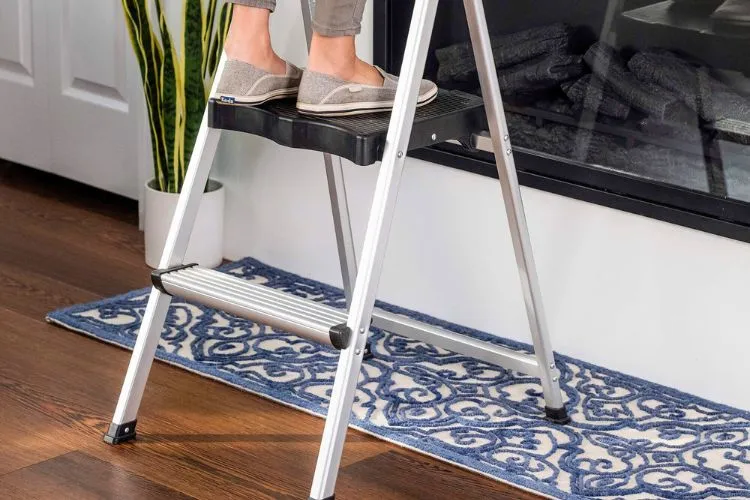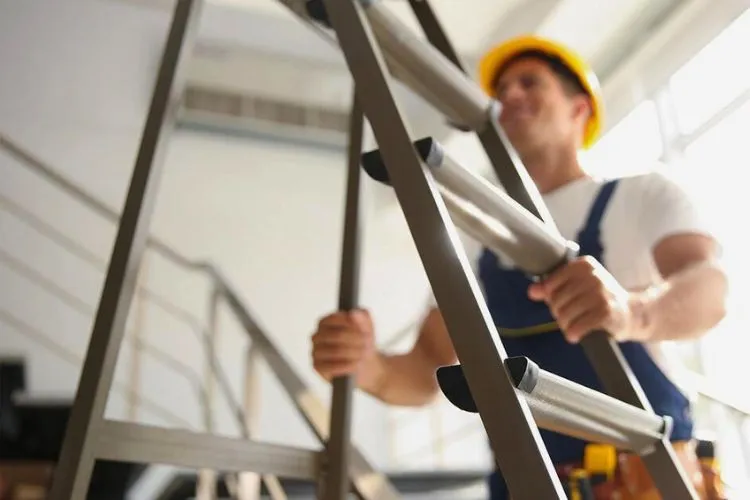Choosing the right ladder for your needs is more than a practical decision—it serves as a cornerstone of safety whether you’re tackling a home project or working on a professional job site.
In the realm of ladders, two types stand out for their versatility and widespread use: step ladders and portable ladders.
In this step ladder vs portable ladder article, we will try to understand the differences, advantages, and appropriate applications of each can significantly impact your productivity and safety.

The Basics of Step Ladders
Step ladders are self-supporting, meaning they do not require a wall or another structure to lean against. This feature alone broadens their usability, especially for tasks like painting a room or changing a lightbulb.
Typically, step ladders have a hinged design, allowing them to fold out into an A-shape. This design provides stability but does limit their height range.

There are several types of step ladders, with front step ladders and twin step ladders being among the most common. While front step ladders have steps on one side and a supportive frame on the other, twin step ladders offer steps on both sides, allowing for two users simultaneously or easy access to tools from either side.
Materials used in the construction of step ladders include aluminum, fiberglass, and wood. Each material offers different benefits. Aluminum is lightweight and resistant to corrosion, making it ideal for general use.
Fiberglass, while slightly heavier, is non-conductive, making it safer for electrical work. Wood, though less common, offers durability and natural insulation but requires more maintenance to prevent degradation.
Pros of Step Ladders
One of the main advantages of step ladders is their stability, thanks to their A-frame design. This makes them particularly user-friendly for indoor tasks or jobs that require a steady hand.
Another benefit is their self-supporting nature, eliminating the need for additional stabilization. Additionally, many step ladders come with built-in safety features, such as wide steps for secure footing and top caps that can hold tools or small parts.
Cons of Step Ladders
However, step ladders are not without drawbacks. Their bulkier design makes them more challenging to store than slim, foldable portable ladders.
Their reach is also limited to their height, with most step ladders not suitable for tasks requiring significant elevation. Moreover, ladders made from conductive materials like aluminum are not advisable for use near electrical hazards.
The Basics of Portable Ladders
Portable ladders, as the name implies, are designed for easy transport and flexible use. Extension ladders, telescopic ladders, and folding ladders fall under this category, each adaptable to various tasks, from gutter cleaning to warehouse work.
Extension ladders can reach significant heights and are ideal for outdoor work on buildings or trees. Telescopic ladders offer compact storage and adjustable length, making them a versatile option for different job sites.

Folding ladders, much like step ladders, can stand on their own but have hinged designs that allow for multiple configurations.
Materials for portable ladders often mirror those of step ladders, with aluminum and fiberglass being prevalent for their balance of weight and durability. Aluminum is favored for its lightweight properties, while fiberglass remains a top choice for electrical safety.
Pros of Portable Ladders
Portable ladders excel in versatility. Their length can be adjusted to suit the task at hand, and their design allows for easy transport and storage.
This adaptability makes them suitable for a broad range of activities, from residential projects to industrial applications. Additionally, their ability to fold or collapse can make them more space-efficient than step ladders.
Cons of Portable Ladders
The primary disadvantage of portable ladders is their need for a stable surface or structure for support. This requirement can limit their use in certain environments and poses safety risks if not properly secured.
Furthermore, portable ladders can be unwieldy, especially at longer lengths, requiring careful handling to prevent accidents.
Step Ladder vs Portable Ladder: A Comparison Guide
Safety is paramount when using any ladder. Adhering to weight limits and regular inspections can prevent many common accidents.
Ensure the ladder is set on stable ground and fully locked in place before climbing. For step ladders, maintain a centered position to avoid tipping. With portable ladders, always extend them fully and lock them before use to prevent collapse.
Choosing the Right Ladder for Your Task
Selecting the right ladder involves evaluating the job’s requirements. Consider the height, duration, and location (indoor or outdoor) of the task.

For short-duration tasks requiring stability, a step ladder might be ideal. For tasks requiring more height or adaptability, a portable ladder could be more appropriate.
Material is another important factor, with fiberglass being preferable for electrical work due to its non-conductive properties.
Maintenance and Care
To ensure longevity and safety, routine maintenance and proper storage are crucial. Inspect ladders regularly for signs of wear or damage, and store them in a dry, secure place to prevent corrosion or other deterioration.
Follow the manufacturer’s guidelines for cleaning and maintenance to keep your ladder in optimal condition.
Frequently Asked Questions (FAQs)
Can a step ladder be used as an extension ladder?
No, step ladders and extension ladders have different designs and uses. Using a step ladder as an extension ladder can be unsafe.
How do I determine the right ladder height for my job?
Consider the highest point you need to safely reach. Your ladder should be tall enough to reach this point without standing on the top three rungs.
Are fiberglass ladders better than aluminum ladders?
Fiberglass ladders offer the advantage of being non-conductive, making them safer for electrical work. However, aluminum ladders are lighter, making them easier to transport.
What are the signs that indicate a ladder is no longer safe to use?
Signs include cracks, bent rails, loose or missing parts, and worn feet. Any of these issues can compromise the ladder’s safety.
How often should ladders be inspected for safety?
Inspect your ladder before each use to ensure it’s in good working condition.
Conclusion:
Choosing between a step ladder and a portable ladder depends on the specific requirements of your task. Consider factors like height, stability needs, and whether the work involves electricity.
Remember, no matter which ladder you choose, safety should always be your top priority. By selecting the appropriate ladder and following safety guidelines, you can complete your tasks efficiently and safely.


